ERIK LEROUGE
- ERIK LEROUGE YACHT DESIGNS
- 85240 FOUSSAIS-PAYRE
54 year old, married, 1 boy.
Erik LEROUGE started sailing in 1960. He successfully raced his designs in events such as Speed Weeks, Bol d'Or, Trophee des Multicoques, F28 European Championship, MULTI 2000 Challenge, Transat des Alizes, Transat des Passionnes, RORC Championships, JOG Championships or Sydney Harbour 18 footers Worlds. He enjoys very much cruising single-handed as well as crewed, offshore or coastal. He test sailed or delivered his latest designs in most part of the world.
His son Aubert shares the same love for see. He is a keen Optimist racer when he does not sails with his father.
Erik LEROUGE has often partly or completely built his own boats. He feels that the experience gained is essential to advise homebuilders as well as to know the problems faced by professional builders. Planning to built his eleventh sailing yacht!
- Vice-president of the Institut Francais des Architectes Navals.
- Member of the Association des Multicoques Habitables directing committee, in charge of the International MULTI 2000 rule.
- Rear-commodore of Nautisme-Fontenay-Mervent.
- Seats at ISO meetings on sailing yachts stability and scantlings.
Soaring is his main hobby. Currently building a motorglider.
YACHT DESIGNER
Since 1976, Erik LEROUGE, IFAN naval architect, has designed over 300 different sailing yachts built all over the world. His cruising designs have crossed many oceans with family crews while his racing designs gained trophies in Multihull Grand Prix, Lake racing or Short handed racing.
Erik LEROUGE has an impressive technical background and his design concepts has been validated by tank testing.
All new drawings and all updates of stock plans are done in CAD using Maxsurf for hulls, TopSolid for 3D modelling and Autocad for 2D building plans. They are metric, in English or French. Drawings are printed on an A0 jet plotter. Perspective drawings or brochures are printed on an A2 colour jet plotter or stored on a CD-ROM.
Contracts and of drawings are based on the IFAN Naval Architect practice.
Main racing successes as skipper or crew on his designs -Takes part in SYDNEY HARBOUR 18 FOOT SKIFF 1978 Open World and French championships. -Wins many club races, 1985 Shamrock cup and 1986 Otis cup with RED MAGNUM, 36' ULDB. -Wins 1984, 1985,1986 et 1987 Brest Speed weeks (Open French speed record), 6th at 1986 Bol d'or (on 550 boats), 12th at 1987 Bol d'or (1st French) with HARO, 38' racing catamaran. -Wins 1984, 1985, 1986, 1987 and 1990 Trophee des Multicoques, 1986 UNM cup and SAM , 1986 and 1987 Challenge Multicoques Mag with INOUI, 40' catamaran cruiser-racer. -Wins 1985 Double Cup with VILLE AUDRAIN, 43' production catamaran. -Wins 1986 GP de Benodet, 1988 and 1991 Trophee des Multicoques, 1988 SAM, 1988 Challenge Multicoques Mag and 1998 Le Tour Dauvergne with various AZULI, 38' production catamarans. -Wins 1987 Grande M, 1987 Challenge Multicoques Magazine and 2nd 1987 MICRO European championship with CATMAN MICRO, 26' production catamaran. -5th of 1987 Transat des Alizes first leg with PAMPERO, 43' production ULDB. -Wins 1989 GP de Cornouailles with NATHANAEL, 31' production catamaran. -3 best days at 1990 Brest Speed week, wins 1990 GP de Torquay and 7th of 1990 F28 European Championship with BARON NOIR, 28' racing catamaran. -Wins the coastal race, first leg and 3rd of second leg in 1991 Transat des Passionnes 1991, wins Tour de l'Ile de Re 2000 and 2002 with various FREYDIS, 46' production catamaran. -4th of 1996 MICRO European championship with KUPPERSBUCH, 26' racing trimaran. -Elapsed time winner of 1997 Multiforbans with SPIRIT, 35' catamaran. -Elapsed time winner of 1998 Trophee Le Monde du Catamaran with MAVIE, 55' production catamaran.
Some other victories of Erik LEROUGE's sailing designs 1986, 1994 and 1995 Multitonic, 1996 Multithaunic, Challenge Menu, Cowes-Dinard, Coupe de Normandie, 24H de St-Cast, 24H de Cherbourg, Geneve-Rolle-Geneve, Route du Rhone, General Guisan, 1989, Semaine de La Rochelle, 1989, 1994 et 1995, 1997 and 2001 Tour de l'Ile de Re, Semaine d'Horta, 1993, 1994 and 1995 Trophee des Multicoques, 1994, 1998 and 2001 Barqueira, 1993 Transmed des Passionnes, 1993 and 1994 Challenge Multicoques Mag, 1995 and 1996 Challenge AMH, 1996 EUROPE 1 STAR , 1996 MICRO European championship, 1996 MULTI 2000 Open Europeans, 1997 Multiforbans, 1997 MICRO British Nationals, Pop Yachting, Challenge Inter-Entreprises, 1998 Grand prix de St-Georges de Didonne, 1998 Multiforbans, 1999 Dresdner C.I. Challenge, 1999 Casino's cup, 1999 Vire les Isles, 2000 Pierre Sangan, 2002 Gascogne-Asturias, 2003 Saguenay-St Pierre, 2003 Route des Hortensias, 2003 Teleregatta, 2003 Tulokset, 2004, 2005 and 2007 MultiMalo, 2004 24-Uurs Zeilrace, 2004 Round the Island, 2004 and 2005 Emasalon lenkki, 2004 and 2006 Henry Lloyd, 2005, 2006 and 2007 Multi d'Automne, 2005 Tour de Cordouan, 40' Trophee SNSM, 2005 IMM, 2006 Alant Runt, 2006 MMM Kilpailut, 2006 Cowes-Dinard, , 2007 Monirunhko ratakisa, etc.
Some good performances of Erik LEROUGE's sailing designs in International racing 1984, 1988 and 1992 OSTAR, 1985 RBR, Multicup, EDHEC, Nioulargue, GP de La Rochelle, Route des 3 caps, 1988, 1991 and 1995 IMM, 1989 to 2005 Bol d'or, 1993, 1994, 1995 and 1997 MICRO Europeans, F28 World championship, 1993 Transat des Passionnes, 1994 and 1999 Transmed des Passionnes, 2004 The Transat, 2005 Transat Jacques Vabre, etc...
Many voyages are done by Erik LEROUGE's sailing yachts, some even completed their third time around or been around Cape Horn!
- Progettisti e designers Francesi
- Pagine che utilizzano DynamicPageList

Navigation menu

An Interview with Multihull Designer Erik Lerouge
Here is an interesting exchange that I had recently (April 2009) with the noted French multihull designer Erik Lerouge. As one of my personal favorites, I have long admired his work, being most notable for designs that both look great and sail efficiently. Windage is kept low, wing decks high; combined with overall high beam, floats of high volume and very efficient rigs, often with rotating wing masts. His "Azuli" and "Freydis" designs have been particularly successful.

MW: Can you please first give my readers an idea of your sailing background? EL: I started sailing a TORNADO in 1970. Then bought an IROQUOIS with my father a year later and started designing multihulls in 1976, now having signed off on over 400 different sailing designs, the majority of which have been catamarans. After a few one-offs, I designed the PULSAR 26 which was a highly successful racing and cruising trimaran. A nice blend of comfort, seaworthiness and performance all in a trailerable package. From this, the PULSAR range was developed.
Most interesting is the PULSAR 30 "TROU NOIR" which did very well racing in Finland. Also creating a fascinating history was the PULSAR 50 called "RAYON VERT" a true Class 50 that was homebuilt by a couple in their fifties in only 2 years. She was entirely laminated under vacuum over male plug moulds and had carbon beams, board, mast and boom. The couple then left for a troublefree 3-year Round the World cruise with no other multihull experience other than a couple of sails on a HOBIE 16!
I have become very interested in foil stabilized trimarans. This is something that continues to interest me and I am looking forward to the trials of DINABAR.
MW: Have you used any tank testing in the design of your hulls and if so, how are your designs better because of them? EL: I did do some research on catamaran hulls. First it was to prove my point with regards to forward section dynamic lift and then to optimize stern sections. At that time, there was the debate between fine sterns and flat transoms. This has been extremely useful and I have used these results on all my multihull hulls.
MW: Do you know of other designers that use tank testing to predict and improve performance? EL: This is usually only done for high profile racing programs, such as for'Groupama 2'. I personally do not feel there is a lot more to learn re basic hull shapes. The overall concept is more important and the challenge now is improving behavior in waves of ever faster multihulls. As this cannot yet be analyzed in tank tests, there is fortunately still room for intuition and experience!
MW: Based on any tank test results you may have seen for very slim hulls, what % of the total hull resistance for a typical multihull ama or hull, is frictional compared to wave making? EL: There is no simple answer. It all depends of the range of speed you are considering. In any case, frictional drag is fundamental so there is absolutely no hydrodynamic reason to design wide flat-bottomed hulls. Only the ends might be adjusted for the speed potential or wave behavior. Fine sterns are good at low speed in calm waters but poor at high speed or to damp pitching.
MW: How does the performance of your smallest multihull (26') compare to others out there? EL: Sorry, but it is illegal in France to make these kind of comparisons… our vision of morality! But the main difference with the competition is that my boats have full length, high buoyancy floats. This gives outstanding rough weather ability and allows one to carry a powerful rig.
MW: For a smaller trimaran, do you have any preferred folding system that you'd recommend? EL: It's plain nuts and bolts! This is light, stiff, reliable, cheap and easy to built and maintain. Although folding systems are well marketed, they are rarely used in Europe. But all systems have their drawbacks: Swing-wings exceeds towing width for a roomy 26 footer and increase overall length in marina. What's the point of such a complicated system if you still need to unbolt the floats for transport? Or if you have to pay a size up for marina fees?
(Ed: this unbolting is no longer the case with the latest Dragonfly models. However, Erik points out that "in Europe, this can still be an issue as max. towing width is 2.55 m or 8'-4". Towing in Europe and America is not the same. Neither are the roads, cars or distances".)
On other systems, access from a pontoon, fouling on the topsides, stability in difficult conditions, height on the trailer are other problems. All folding systems work better with small floats so for conventional trimarans, this is bad news.
My PULSAR models get their performance and safety from their large and long floats, that are just not suitable for folding systems. In my opinion, folding systems require a total rethink of the trimaran concept, with really small floats, most likely foil assisted.
MW: Is it possible that you'll soon be designing a smaller multihull that might interest our readers? EL: The PULSAR 23 is a new model. It is presently conventional but it may evolve into a foil-stabilized folding trimaran.
MW: Can you elaborate more on this new 23' model? EL: Our program is not to do the fastest 23' tri around but a simple, practical, safe fast cruising trimaran. She will be towable with a simple French driving license. (A special license for towing is required in France if total weight of vehicle + trailer exceeds 3.5 tons.) Originally, she was to be a smaller sister to the Pulsar 26. No more standing headroom, just seating. So that it could be lighter and less voluminous to transport. The 7 m length limit avoids certain taxes in France. Then to further reduce building costs and keep a nice interior, I decided to eliminate the dagger board in favor of float keels as already fitted on the Pulsar 33. These were inspired by my successful catamaran keels. See: www.lerouge-yachts.com/cat_TKS.htm
MW: What particular aspects are you testing for, re any new project and will you be reporting on any of this work later on? EL: A problem for trimarans is that they are more expensive to build than catamarans. They require more moulds, have more hulls and more skin area—and also lots of stability [that demands a stronger rig etc]. I am working on this problem and something may happen if I find the correct boatyard willing to invest in this market.
MW: Balanced against cost, do you have any preferences for construction materials for smaller multihulls? EL: Without any doubt, foam-sandwich is ideal for 90% of the cases. Strip planking is a good economic choice for a home-builder in countries where proper wood is readily available and foam prohibitively expensive to obtain.
MW: For foam sandwich, do you use large sheet layup over male stations, or vertical or horizontal strip? And do you use vacuum bagging or hand wet layout? EL: Depends of shape, availability of materials and budget. For one-offs: assuming Airex foam is the choice, I use sheets on a battened male mould for the main hull. Many were built using Corecell foam strips however. Always longitudinally over stations, with the main hull over male sections while the floats were in half female sections, having a joint at the centerline. All this can be done in hand wet layout. If the lightest weight is desired, then I use a male plug, foam sheets and vacuum bagging.
For production boats: all are done in female moulds and resin infusion has become the norm.
MW: What is your latest thinking on % of ama buoyancy? EL: On conventional trimarans, such as my PULSAR, I go for nearly 200%, for both safety and power. On a foil stabilized trimaran, just 90% would be interesting to give a nice static stability curve up to 90° without the main hull lifting.
MW: What has been your experience using a significant knuckle in the main hull re making the boat drier and/or adding interior space or any other reason? EL: I have used a significant knuckle on the PULSAR 26 to be able to fit a nice accommodation within the length limit of the old Micro-Multihull rule. The foredeck then became wider and more comfortable. But the knuckle generally increases building time as well as skin area and weight and can also catch waves. For the same cost of materials, I would prefer to design a simpler but longer hull with simple flare, such as on my PULSAR 31. In normal sub-gale conditions, the knuckle also adds to the dryness of the boat.
Comparing boats by their length has always been the big drama of yacht design. This is done for harbour fees, custom, racing rules or whatever. But what should be really important is to design 'the best boat for a given budget'. For that, a longer simpler boat is difficult to beat. It is undisputed fact that a longer, narrower main hull will be more seakindly than a shorter, wider one.
MW: One can note that many of your designs have wing masts. Do you design these yourself and if so, what is your approach? For example: Do you spread the boats maximum righting moment over the length of the mast - opposed by the two supporting points—the mast step and the hounds (where the shrouds are attached)? EL: All my designs have rotating masts for obvious reasons! .. they are more efficient. When available, aluminum masts are cost effective so I have been pushing mast manufacturers to invest in suitable extrusions for rotating masts.
The ideal is a carbon mast and there are several good manufacturers with suitable moulds and an autoclave who are able to make the lightest masts with high-modulus for a realistic price. Personally, this is the first place where I would put my money on a boat. Some carbon masts are made by the boatyards themselves or even by homebuilders. I have designed and built a couple for myself but while the result is better than an aluminum tube, with low-modulus carbon and "only" vacuum techniques, it cannot compare in weight with the best carbon mast manufacturers.
In some cases, a suitable aluminum rotating mast does not exist for the size of the boat, or is too expensive to import and a carbon mast exceeds the available budget. In such a case, I have designed a plywood/epoxy/carbon wingmast which can be built in 200-300hrs with minimal material cost. The weight is close to that of aluminum but with a far greater chord. The mast is also stiffer and we can save a lot on the rigging. But I am not marketing these masts designs. They are done as an added service to my clients when it seems the best answer.
The engineering of these masts depends of the sailplan. Mainsail loads are spread, while the jib and spinnaker loads are concentrated. Worst cases of sailing are analyzed in various sail configurations, noting that some parts of the mast work in bending, others in compression. In some cases, I could eliminate the spreaders.
MW: For your plywood/epoxy/carbon wingmasts, is all the load taken by the carbon or is the mast primarily built with fibreglass over the ply and only supplemented by carbon at high stress areas? EL: Fiberglass is only there to protect the plywood and with its low modulus has a very small influence on mast thickness. Stress is largely taken by the ply skin and beams. Their scantlings are mostly dictated by the building process. Carbon is cost/weight effective to take the remainder of the load.
MW: Merci beaucoup Erik for your time and enthusiasm to answer these questions for my readers. EL: You are most welcome. Au revoir et bonne chance!
We recommend that our readers also visit Erik's website. Go to www.lerouge-yachts.com/trimarans.htm and this links to many of his wonderful boats as well as good info on various building methods.
Interesting also for the pics (text in French) is this website from a Pulsar 26 enthusiast trimarandiomedea.free.fr/ Also for the pics (text in Finnish) is this site on the Pulsar 30 'Trou Noir': www.trounoir.fi/trimaraani
"New articles, comments and references will be added periodically as new questions are answered and other info comes in relative to this subject, so you're invited to revisit and participate." —webmaster
"See the Copyright Information & Legal Disclaimer page for copyright info and use of ANY part of this text or article"
Great choice! Your favorites are temporarily saved for this session. Sign in to save them permanently, access them on any device, and receive relevant alerts.
- Sailboat Guide
Manta 40 is a 39 ′ 7 ″ / 12.1 m catamaran sailboat designed by Erik Lerouge and built by Endeavour Catamaran Corp. and Endeavour Yacht Corp. starting in 1994.

Rig and Sails
Auxilary power, accomodations, calculations.
The theoretical maximum speed that a displacement hull can move efficiently through the water is determined by it's waterline length and displacement. It may be unable to reach this speed if the boat is underpowered or heavily loaded, though it may exceed this speed given enough power. Read more.
Classic hull speed formula:
Hull Speed = 1.34 x √LWL
Max Speed/Length ratio = 8.26 ÷ Displacement/Length ratio .311 Hull Speed = Max Speed/Length ratio x √LWL
Sail Area / Displacement Ratio
A measure of the power of the sails relative to the weight of the boat. The higher the number, the higher the performance, but the harder the boat will be to handle. This ratio is a "non-dimensional" value that facilitates comparisons between boats of different types and sizes. Read more.
SA/D = SA ÷ (D ÷ 64) 2/3
- SA : Sail area in square feet, derived by adding the mainsail area to 100% of the foretriangle area (the lateral area above the deck between the mast and the forestay).
- D : Displacement in pounds.
Ballast / Displacement Ratio
A measure of the stability of a boat's hull that suggests how well a monohull will stand up to its sails. The ballast displacement ratio indicates how much of the weight of a boat is placed for maximum stability against capsizing and is an indicator of stiffness and resistance to capsize.
Ballast / Displacement * 100
Displacement / Length Ratio
A measure of the weight of the boat relative to it's length at the waterline. The higher a boat’s D/L ratio, the more easily it will carry a load and the more comfortable its motion will be. The lower a boat's ratio is, the less power it takes to drive the boat to its nominal hull speed or beyond. Read more.
D/L = (D ÷ 2240) ÷ (0.01 x LWL)³
- D: Displacement of the boat in pounds.
- LWL: Waterline length in feet
Comfort Ratio
This ratio assess how quickly and abruptly a boat’s hull reacts to waves in a significant seaway, these being the elements of a boat’s motion most likely to cause seasickness. Read more.
Comfort ratio = D ÷ (.65 x (.7 LWL + .3 LOA) x Beam 1.33 )
- D: Displacement of the boat in pounds
- LOA: Length overall in feet
- Beam: Width of boat at the widest point in feet
Capsize Screening Formula
This formula attempts to indicate whether a given boat might be too wide and light to readily right itself after being overturned in extreme conditions. Read more.
CSV = Beam ÷ ³√(D / 64)
Based on an earlier design (FREYDIS) by Erik LeRouge. Extended version of the MANTA 38. Extended further for the MANTA 42.
Embed this page on your own website by copying and pasting this code.
- About Sailboat Guide
©2024 Sea Time Tech, LLC
This site is protected by reCAPTCHA and the Google Privacy Policy and Terms of Service apply.
Erik Lerouge
Designed sailboats
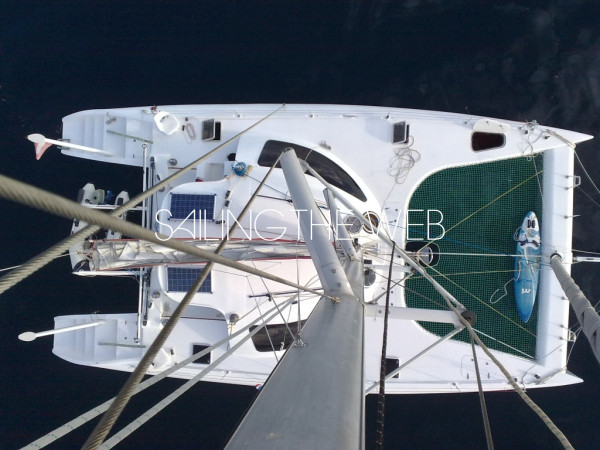
Barramundi 470
Builder name.
Barramundi Boatyard
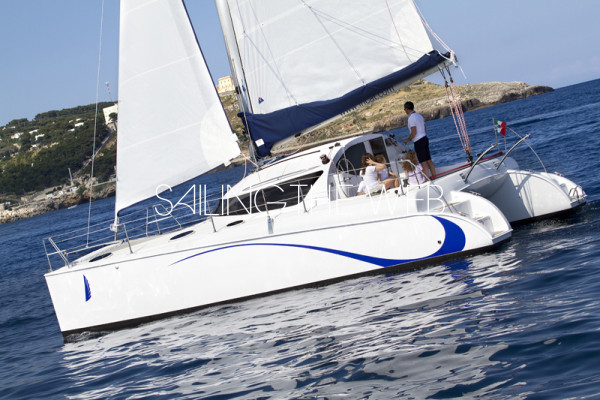
Lady Hawke 33
Lady Hawke Catamarani
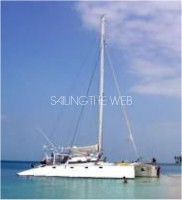
Soubise Plaisance
NOTE: you will be redirected to another website.

804 815 1233
Freydis 46 Catamaran Sailboat by Erik Lerouge
Cénou
Fast, comfortable and fun to sail.
Cénou is a Freydis 46 designed by Erik Lerouge. It offers a blend of comfort and performance. Able to sail at or better than wind speed in lighter winds, Cénou is easily driven and will average 8 to 10 knots all day in heavier air, rewarding those who like to sail without leaving behind comfort. Because the boat is so responsive to sail trim and gives quick feedback, it is a helpful platform to improve your sailing skills.
Length: 46 feet/Beam: 26 feet/Weight: 10 tons/ Sail Area: 1,260 sqft on the wind. 2,764 sqft off the wind/ Mast Height off the water: 71 feet/ Propulsion: 2x39 hp Yanmar/ Fuel: 60 gallons/ Water: 100 gallons/ Water maker/ Electrical: 12V, 24V and 110V AC/ Satellite communication/ 11'6" RIB with 20HP
- 0 No item in your cart
- SUBSCRIPTION
- Classified Ads
- Technical Specifications
- Destinations
- Address book

- All the magazines
Libertist 853 folding version - One standard marina slip please
Folded, unfolded... you gain 4’7” (1.395 m) on each side by folding the floats in... but at the same time, the length increases from 28’ (8.53 m) to 35’7” (10.84 m).
Practical info
- Builder : Boat Project
- Technical specifications

- Finance your Libertist 853 - Folding Version
- Available in issue # 192
Boat Test price $5.00 Inc. tax

Add several tests to your cart
and get an extra discount!
Erik Lerouge is well known for his highly seaworthy, performance multihulls - undeniable qualities that the architect defends thanks to an uncompromising vision. The Libertist 853, for example, was launched in a first version with fixed linking arms - simpler, stiffer, lighter... However, Erik was well aware that customers would end up asking for “the same, but in a folding version”. Well, here is this long-awaited new version!
Test location: Les Sables d’Olonne, France Conditions: 8 to 12 knots of wind, slight chop
The problem of the lack of marina slips for multihulls in most of the world’s major yachting regions, and the explosion in prices as soon as the width of a slip starts to get anywhere near its length, logically revives the relevance of the variable-geometry trimaran inventions of pioneers Ian Farrier and Borge Quörning. In the 1980s/1990s, the main objective was to facilitate the transport and wintering of small, economical multihulls - the operation required a good half-day and two strong men to dismantle the floats of an Allegro (1976) or a Speed 770 (1980). Nowadays, the #1 argument for folding trimarans is first and foremost to be able to access a berth - and at the same price as a monohull! Today, this multihull production sector is relatively prosperous (even if volumes remain low in relation to overall production). Manufacturing and selling folding trimarans within a sustainable economic model remains a complicated challenge, as the technique is costly to implement, and prices bear the brunt as a result.
Folding trimarans past and present
Let’s start with the ones that are ...
To read in full, Buy the boat test
Tags :
- trimaran ,
- Boat Project ,
- Libertist 853 - Folding Version ,
- Erik Lerouge
What readers think
Post a comment
No comments to show.
Useful links
- Download the boat test of the Libertist 853 - Folding Version ,
- Charter a Libertist 853 - Folding Version ,
- Purchase a Libertist 853 - Folding Version secondhand ,
- Classified ads Libertist 853 - Folding Version in secondhand multihulls ,
- Discover Boat Project and their Libertist 853 - Folding Version
Share this article
Follow us on, vous avez ajouté " " à vos favoris., vous avez supprimé " " de vos favoris., in order to add this article to your favorites, please sign in..
- 1103 (planned)

Do you want to embark on an exciting journey witch Libertist?
We are looking for dealers..

Our beautiful 853

We have it!
Model 703 is.

"A trimaran that'll take your breath away"
The freedom of sailing at its best..
Libertist stands for freedom, fastness and fun – the pure essence of sailing. It represents the ultimate quality of craft production and innovative materials. An ultralight carbon rotating mast equipped with mini foils and cutting-edge electronic solutions have been created to satisfy the needs of the most demanding sailing fans who truly cherish the sport.
Libertist redefines the feeling of liberty.

Why Libertist?
Top quality materials, innovations and craft precision

The most up-to-date cruiser-
racer constructions on the

Extremely low mass nesures
unrivalled speed and security

Permanent mini foils, large
volume floats

Carbon rotating mast

Cutting-edge electronic
solutions by the French
company NKE

The sails by Ocean Sails

Full standing height
(headroom), electric engine

Designed by one of top
constructors in the industry

Built in a renown Polish

Disassembled and folding
floats - comfortable transport
in a trailer
On water? Full on excitement!
Let’s see what those who caught the wind in their sails with libertist have to say.

Erik Lerouge, water and wind architect
An experienced sailor who often participates in regatta races, a devoted sailing fan with vast expertise, and impressive experience in yacht design
No matter whether he sails downwind or upwind, his designs always go against the current. They are characterized by an innovative approach towards applied solutions, excellent quality of the materials used, and ultimate precision and robustness confirmed by rigorous testing. He designs for highly demanding customers – the sailing fans in search of the new definition of freedom. Due to Lerouge’s professionalism and passion, his projects have been acknowledged around the world for decades. His portfolio features many monohulls, double-hulls and trimarans. In 2016 he cooperated with a Polish investor to create dedicated hydrofoil trimarans.
„When creating Libertist 853 I was given full freedom to improve the ever-problematic compromise between comfort and nautical qualities that I am so attached to. The 28 feet size has been chosen to fit a sizable saloon, a bow cabin, a double cockpit bunk bed, a galley and a separate toilet, while ensuring spaciousness and full standing height. It was also crucial that floats and beams were easy to disassemble for comfortable transport. The idea to add extra mini foils has been in my head for a while. The efficiency of foils has been systematically increasing, yet some new solutions are still required. The goal is not to fly, of course, it is rather to increase the security and control the pitching in greater speed. The yacht has been beautifully constructed by Rega Yacht. The design is timeless. The tests have confirmed our expectations on maintaining control while sailing downwind and reducing pitching in tougher weather conditions.”

Select Service
Service Category — Any —
Service * — Select —
Location — Any —
Employee — Any —
Select Date & Time
Your Reservation
Total: € 0
Your Information
Required fields are followed by * .
Booking notes
Back Reserve
Payment Method
Sorry, it seems that there are no available payment methods.
Making a reservation...
Back Add New Reservation
Log in or Sign up
You are using an out of date browser. It may not display this or other websites correctly. You should upgrade or use an alternative browser .
New 850 tri by Erik Lerouge
Discussion in ' Multihulls ' started by Libertist , May 26, 2017 .
Libertist Junior Member
Hi Guys, New here - Good Day! We are building new tri - Libertist 850 - Erik Lerouge bigger P26. Feel free to comment.
Attached Files:
Img_2538.png.
Floats
IMG_2603.PNG
Main hull
IMG_2640.JPG
Doug Lord Flight Ready
Looks good! Are the ama foils retractable?
Thank you ) No. Fixed one. Easier simpler KISS

Corley epoxy coated
Looks great Libertist, do you have a target displacement for the boat? Will it run a bigger rig than the P26?
Thank you very much. Design one is 1400 kg and we aim for this. (Payload 700 kg) The main sail is 40 square meters, jib 19 and spi 78. But we are going to develope and research 6 additional, optional sails for her. Mast is 13,6 and 4 sq.meters.
IMG_2686.PNG
Libertist said: ↑ Thank you very much. Design one is 1400 kg and we aim for this. (Payload 700 kg) The main sail is 40 square meters, jib 19 and spi 78. But we are going to develope and research 6 additional, optional sails for her. Mast is 13,6 and 4 sq.meters. Click to expand...
Female mould. Epoxy. Carbon beams. Demountable.
Tadam DD
IMG_2702.JPG
The beast is born )
IMG_2918.JPG
Looks good!
jorgepease Senior Member
Nice!!
Finally
7166930C-2A44-4CDE-8EEC-F8BA5D782AFF.jpeg
0875f1bd-1e3c-485f-a345-a45d06e2db17.jpeg.
- Advertisement:
bateau-libertist-yachts-853-5314001-yb.jpg
Bateau-libertist-yachts-853-5314002-yb.jpg, bateau-libertist-yachts-853-5314005-yb.jpg.
Chinese electric winch?
Design of wood epoxy trimaran beams
Normon Cross Trimarans
Trimaran Build
FAO 7.8 meter trimaran ocean capable?
Best free CAD for trimaran design
Designs of catamarans not in metric but SAE
Outrigger canoe Ama design considerations
Cross Beam thoughts for small Tri
Unstayed mast build for small canoe based trimaran.
- No, create an account now.
- Yes, my password is:
- Forgot your password?


Compare Sailboats
- Sailboat Calculators
- Bluewater Sailboats
- Catamarans and Multihulls
- Sailing Liveaboard
- Sailboats Galley
- How Much it Costs
- Sailing Destinations
- Meteorology Terms
- Sailing and Nautical Terms
- Parts of a Sailboat
- Great Explorers
- People of the Seas
Erik Lerouge
- Designer : Erik Lerouge
- Designer Country : France
- Designer Website : http://www.lerouge-yachts.com
- Description : Located in FOUSSAIS-PAYRE, FRANCE
OceanWaveSail Free Searchable Sailboats Designers Database
Designer's boats, subscribe to our newsletter, don’t miss new updates on your email.
© OceanWave Sail. All Rights Reserved 2022
Terms & Conditions – Privacy Policy – Cookie Policy
About Us – Privacy Policy
- New account
Forgot your password?
Lost your password? Please enter your email address. You will receive mail with link to set new password.
Back to login
Privacy Overview
Dynamic title for modals, are you sure.
- € 0.00 0 items
- Lagoon Announce New 43 Sailing Catamaran
Lagoon have released the first images of their new model, the Lagoon 43.
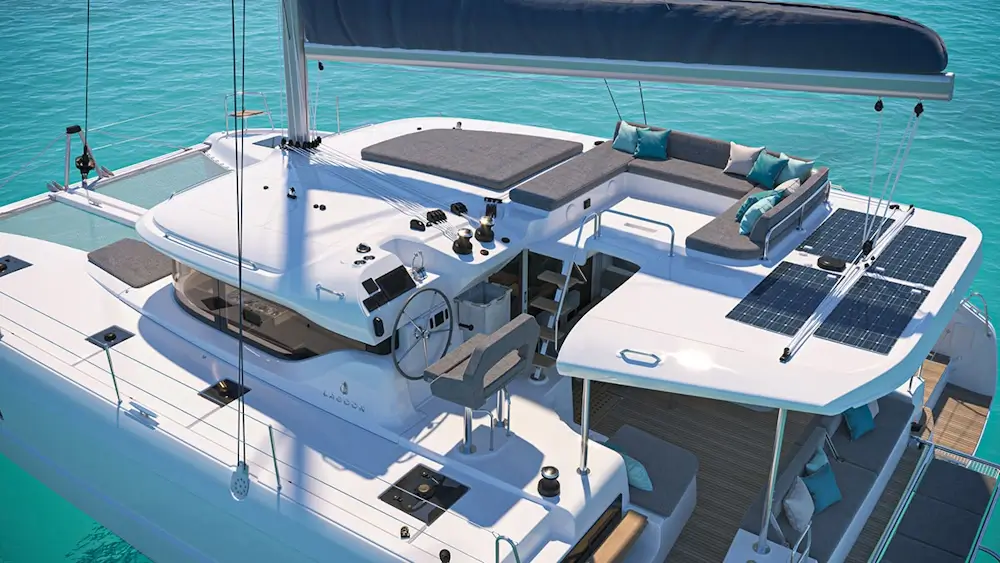
New for 2024, the Lagoon 43 pulls in design elements of the 55, 51 and 60 into a new forty-three footer sailing catamaran. Read our Lagoon 43 Review for more details on this sailing catamaran. ▫️ More details: on “ Club Lagoon “. She’ll be shown at the Cannes Yachting Festival 2024.
Lagoon will be sharing more details at the 2024 International Multihull Show .
- Webcam – Club Marítimo Castelldefels
- Lagoon World Escapade 2024
- First Vaan Yacht in “Vivid Alu”
- La Grande Motte – a Coastal Gem
- Lagoon 60 Launch and Some History
- Marine Electric Engines: How They Work
- Windelo Catamaran Partner with Just Catamarans
- Excess Campus
- Lagoon Update, Oct 2023
Browse, search and find your perfect catamaran!
Privacy Overview
- Custom Cats
- Performance Cats
- Cruising Cats
- Luxury Cats
- Owner Reviews
- YT Channels
- Hispanoamérica
- Work at ArchDaily
- Terms of Use
- Privacy Policy
- Cookie Policy
Moscow Has a New Standard for Street Design
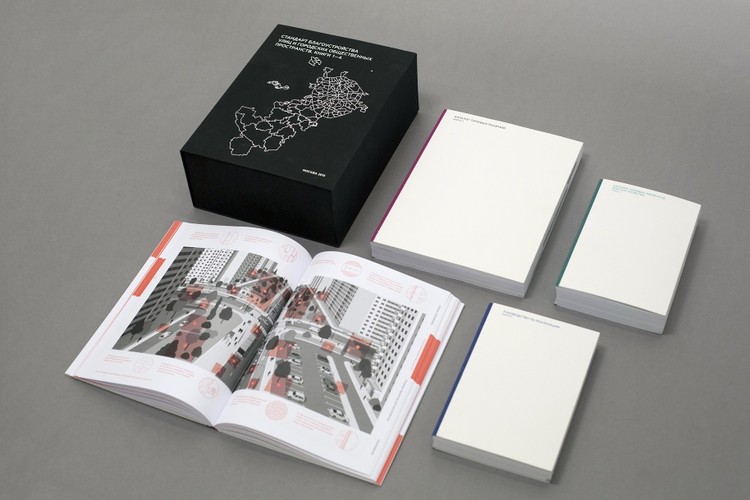
- Written by Strelka Magazine
- Published on August 25, 2016
Earlier this year the development of a new Street Design Standard for Moscow was completed under a large-scale urban renovation program entitled My Street , and represents the city's first document featuring a complex approach to ecology, retail, green space, transportation, and wider urban planning. The creators of the manual set themselves the goal of making the city safer and cleaner and, ultimately, improving the quality of life. In this exclusive interview, Strelka Magazine speaks to the Street Design Standard 's project manager and Strelka KB architect Yekaterina Maleeva about the infamous green fences of Moscow, how Leningradskoe Highway is being made suitable for people once again, and what the document itself means for the future of the Russian capital.

Strelka Magazine: What is the Street Design Standard and what does it include?
Yekaterina Maleeva: The Street Design Standard is a manual for street planning in Moscow . The Standard is divided into four books, each one of them covering particular aspects of street design. Many cities across the globe have developed their own standards and the concept has gained a lot of popularity over the last decade. The New York Street Design Manual is a famous example; the book has even been translated into Russian. However, Moscow streets have little in common with New York streets, for example; every city has its own unique urban typology and simply copying existing solutions from another manual is not a viable option.
When we started our work on the Standard , the first thing we did was study Moscow streets, their peculiarities and common features. The first volume of the Standard focuses on the typology and distinctive attributes of the streets of Moscow. We gathered data on more than 3,000 streets and processed the data. Despite the large sample size, we discovered certain similarities. We managed to identify ten of the most common street types, but some unique streets could not be categorized. For instance, Tverskaya Street, built in 19th century, originally fell under category "10C." But after it was widened in the 1930s, Tverskaya ended up in a unique place within the urban fabric of Moscow. Such objects as that require a case by case approach and an individual project.
What can be found in the other volumes?
After we identified these ten street types, we started working on defining the best way to approach the development of each. The second book describes what a street of each type must have. We developed a general profile and functional zoning for each type. The pavement is more than just a pedestrian lane: there is a buffer zone between the roadway and the walking lane where the parking posts, street lights and communication lines are located. It’s a mandatory utility zone that has to be paved in such a way that any section can be easily unpaved and replaced. There is also a pedestrian fast lane for people walking to their workplace and a promenade with benches and other objects. Building façades have a large impact on the street they are facing. Restaurants and shops are located in these buildings. Making the adjacent zone retail-friendly is important. Cafes and restaurants must be able to open street patios to attract customers without disrupting the pedestrian traffic. How to apply these concepts to each of the street types is thoroughly explained in the Standard .
The third book describes eleven groups of design elements, including surface materials, benches, trash bins and lights. This catalogue of elements contains no mention of suppliers. It does not promote any manufacturers; instead it describes the attributes which define a quality product. For instance, the third book explains which type of tree grates will serve the longest while causing no damage to the root system of a tree. Styles of grates, bins, benches and other elements may vary, but all the items must comply with the quality standard.
Finally, the fourth book focuses on the planning process: how to perform preliminary analysis, how to apply user opinions during the development and how to achieve quality implementation. Additionally, there is a special emphasis on the fact that street planning cannot be carried out without any regard for the context of the street. A street should be regarded as a part of an interconnected system of various public spaces, together with adjacent parks, garden squares, yards and plazas.
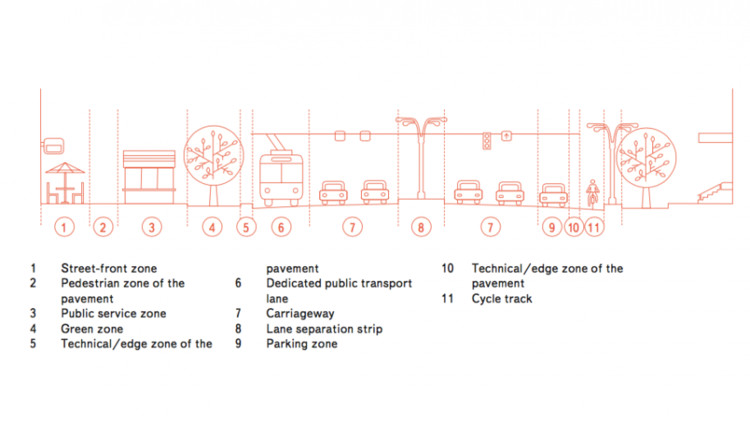
Does the Standard have an official status? Should it be considered a law or merely a guideline?
There are a number of state-level laws and regulations relevant to street design issued by the Moscow Government. They were taken into account during the development of the manual. These regulations ensure safety standards and must be complied with. While the existing legislation covers safety aspects, our books introduce comfort standards. The Standard is basically a non-binding, advisory guideline created with the goal of improving the urban environment everywhere across the capital and maintaining it at a high level.
What happens if a street does not fit any of the mentioned types (and is not as significant as Tverskaya)? For instance, what if a street located in the New Moscow territory has cottages on one side, apartment complexes on the other and an entrance to the Moscow Ring Road somewhere along the way?
A standard is not a ready-made solution. The streets share common features yet also retain their individual attributes at the same time. Applying a single standard profile to every street is impossible. Adjustments are always in order.
The Standard offers three sets of solutions for each type of street with a large potential for combining various elements. The manual basically offers a convenient database that a designer working with a new space could use. That does not mean that all the new projects will look exactly the same. Some solutions featured in the Standard are yet to be implemented anywhere in Moscow . For instance, our collaboration with Transsolar, a German company consulting us on environmental comfort, revealed that Moscow’s largest environmental problem was not in fact CO2, but small-particle dust produced by studded tyre traction. And a simple method to control this type of pollution already exists. Many busy streets outside the city center have a green buffer zone separating the roadway from the sidewalks. A 1.5m high ground elevation running along this zone could filter out up to 70% of the tyre dust, preventing it from spreading into the residential areas. Western countries have been successfully using this technology for many years. Now it is a part of Moscow Standard . By the way, a terrain elevation could also help reduce the level of road noise.
.jpg?1471881026)
Does the Standard offer anything for the main roads? For example, nowadays Leningradskoye Highway basically splits the city into two disconnected parts; it’s a car dominion.
The Standard does not offer solutions for transportation problems. When we were defining our street typology, we relied on traffic load data calculated using Moscow ’s transportation model. We pursued a goal of only offering solutions that would not aggravate the current transport situation. Any planned sidewalk extension or addition of a bicycle lane or road crossing should first be approved by the Moscow Department of Transport.
As for the main roads, our research revealed that the streets with the highest traffic load also have the heaviest pedestrian traffic. One would think that it should be the other way around. However, the main roads have metro stations, which generate a lot of pedestrian traffic, which in turn draws retail. Treating main roads the same way as highways is impossible. The needs of both vehicle traffic and local residents must be taken into account, which creates a paradox.
These territories have every opportunity to become more comfortable. Some have relatively large green buffer zones that currently remain underused. The Standard proposes to augment these zones with additional functionality. On one hand, some of the main streets will gain attraction centers, especially near intersections connecting them to the adjacent residential areas. Weekend markets are one example of such centers. On the other hand, the Standard involves the creation of zones able to absorb extra precipitation flowing from the roads and filter it. There is a list with types of vegetation best fit to handle this task. The same zones could be used to store snow in the winter. The meltwater will be naturally absorbed by the soil, alleviating the need for moving the snow out to melt. This, however, would require decreasing the quantity of melting chemicals sprayed over the snow, as the plants underneath might be susceptible to their effects.
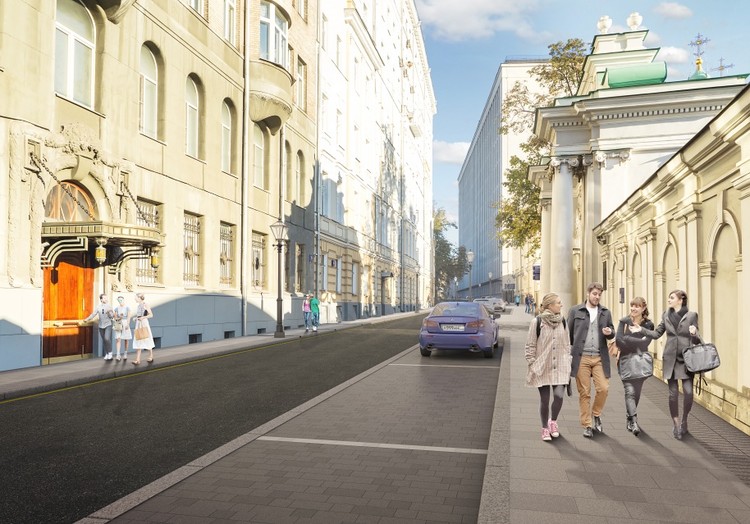
Can the new Standard rid us of green lawn fences, yellow curbs and other eternal eyesores?
The choice of yellow and green appears random, so we have no idea how to actually fight that. The Standard offers no colour schemes. As long as fences meet the set requirements, their colour does not matter. However, currently they seem to fail to comply. The Standard states that lawns do not require fencing. This is a waste of materials: people will not trample grass and bushes just for the sake of it, while dog owners will trespass anyway. There are many other options for protecting lawns from being trampled. For instance, a same-level pavement strip with a different texture could protect a lawn from accidental intruders just as well as a curb can.
Natural soil water absorption is currently largely ignored, with most precipitation going down the storm drains. Meanwhile patches of open terrain on a street are able to absorb water. Employing these natural cycles in street layout could save resources.
Does the Standard provide any financial estimations? For instance, an approximate cost of renovating a street of a particular type?
No, as the Standard does not list any products of any particular brand, there are no prices to refer to. Nonetheless, the Standard was developed to fit three potential price ranges. Whether their estimated price is low or high, all the elements ensure that quality requirements are met. The same quality level must be maintained across the whole city and never drop below the set standard.

Let’s say a world-famous architect arrives to Moscow to design a street. He puts incredibly beautiful things into his project, which, unfortunately, contradict the Standard and are not guaranteed to work as intended. In that scenario, will the architect be told to stick to the Standard ?
This could happen and I think it would be a good thing. If an architect plans to place a sculpture on a 1.5 meter wide sidewalk, would that really be a good idea? Following the Standard ensures smooth movement. Its goal is to reinvigorate the streets. In Copenhagen, new design manuals helped increase average time spent by residents outside by 20% over 10 years. That was achieved through creating convenient and attractive public spaces. Moreover, implementation of the Standard enables the creation of professional documentation for architects, which excludes the possibility of any instructions that will later be unclear to the experts trying to work with them. Finally, the Standard also pursues the task of providing the opportunity for the development of street retail.
Isn’t retail a whole different story? How can retail be introduced in such places as Strogino District, where the ground floors are living floors and have security bars on windows? By reintroducing street vendors?
True, business has no direct relation to street renovation. However, there is a strong connection between them. In Strogino, building façades are mostly located far from the sidewalk. Moreover, facades are often concealed by shrubbery and trees, making local businesses even less noticeable. Another problem is that first floor apartments cannot be used for commercial purposes due to insufficient ceiling height (3 m compared to 3.5 m required minimum). Nonetheless, we discovered multiple examples of shop owners reconstructing apartments in residential districts to meet the requirements.
Our British consultant Phil Wren, a street retail expert, travelled Moscow ’s residential districts and studied the existing examples. He came up with a great idea: building an expansion connected to the façade and facing the sidewalk. This makes it possible both to achieve the required ceiling height and increase the visibility of the business to the passers-by. The part of the shop located in the apartment can be used as a utility room or a stockroom. This way the noise level is reduced, regulations are met and store space is increased. Our Russian consultants confirmed the viability of the proposed concept. And the Standard will ensure that any added expansions will look presentable.
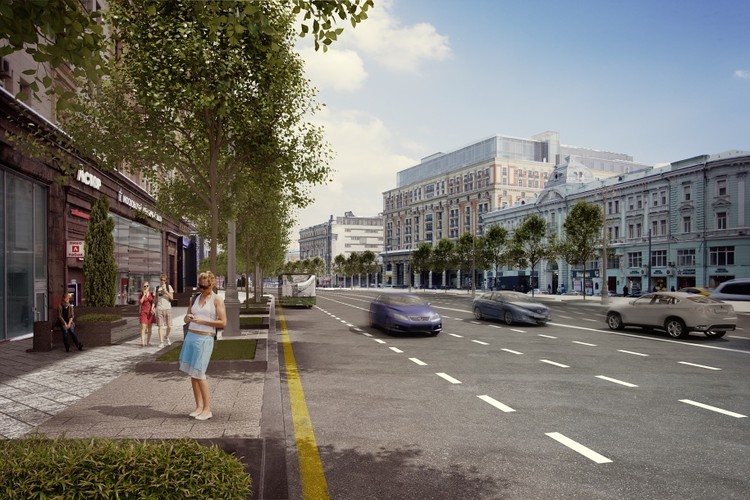
Does the Standard also regulate façade appearances, an architectural element? What should be expected from this? It is unlikely that all houses which fail to comply will be demolished once the Standard is implemented.
Renovation works with what is given. Of course, façades cannot be changed. Central Moscow has a problem with mansions and many other buildings being fenced off, which prevents them from accommodating street retail. Central streets are also relatively narrow. The Standard proposes sidewalk expansion wherever the access to the first floors is open. Street renovation does not always involve planting trees. Some places require enhanced crossings so that people can quickly reach the other side of the street to get to a shop or a café. Those streets where the facades are windowless are a more suitable place to plant more vegetation.
Can an average person – not an architect, designer or construction worker – understand the new Standard , or is it a technical document which can only be interpreted by a professional?
Any person can. The Standard is written in a way that both professionals and common citizens are able to understand. The Standard contains multiple images, photos, infographics and diagrams and is written in plain language. We would love for more people to read it: the books contain many interesting solutions for our city that affect every pedestrian.
In late March it was revealed that Strelka KB would be developing a standard for recreational zones and public areas in Moscow . What differences will that document have from the Street Design Standard ?
The two standards will have a lot in common. The city currently faces a task of developing a connected system of public spaces. The first logical step was to work with the streets which actually connect areas of attraction and other public spaces. Now the work on all other public spaces takes off. Parks, garden squares, yards, water bank recreation areas, plazas near metro stations must all fall into place. Work with these territories will set a single quality standard. In addition, it will improve Moscow ’s quality of life and reduce air pollution. Simple solutions could improve airflow, increase biodiversity and reduce noise levels at the same time.
The renovation program is quite long and depends on numerous standards and documents. But when exactly will the endless repair works end? Are there any time estimations for when all these concepts will finally get implemented?
This is not an easy question. Full renovation may last decades. The Standard is the first step towards actually controlling the renovation process and its timeline. Until now renovation has been proceeding rather haphazardly. Now the city has decided that the way the streets are designed should be clarified. We understand that the Standard cannot last unchanged for eternity and should, just like any regulation, undergo periodical updates. The Standard uses flexible typology: a street of one type could transition to another within a few years under certain conditions, such as changes in its usage and its user categories. Everything must stay regularly updated according to the accumulated experience.
During our work on the Standard , we held regular roundtables joined by experts and ordinary citizens. One of our guests mentioned that he had recently started paying attention to Moscow ’s facades, their beauty and their drawbacks. He was able to do that because he no longer had to watch his step. So the process has already started and we already see some results.

- Sustainability
世界上最受欢迎的建筑网站现已推出你的母语版本!
想浏览archdaily中国吗, you've started following your first account, did you know.
You'll now receive updates based on what you follow! Personalize your stream and start following your favorite authors, offices and users.
- Bahasa Indonesia
- Slovenščina
- Science & Tech
- Russian Kitchen
Le Corbusier’s triumphant return to Moscow
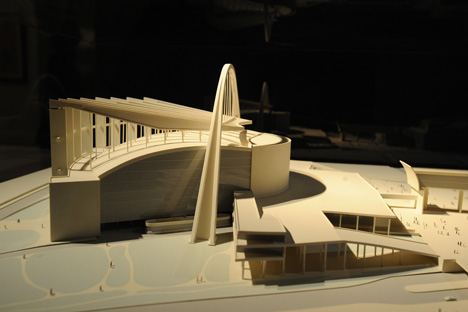
The exhibition of French prominent architect Le Corbusier, held in The Pushkin Museum, brings together the different facets of his talent. Source: ITAR-TASS / Stanislav Krasilnikov
The largest Le Corbusier exhibition in a quarter of a century celebrates the modernist architect’s life and his connection with the city.
Given his affinity with Moscow, it is perhaps surprising that the city had never hosted a major examination of Le Corbusier’s work until now. However, the Pushkin Museum and the Le Corbusier Fund have redressed that discrepancy with the comprehensive exhibition “Secrets of Creation: Between Art and Architecture,” which runs until November 18.
Presenting over 400 exhibits, the exhibition charts Le Corbusier’s development from the young man eagerly sketching buildings on a trip around Europe, to his later years as a prolific and influential architect.
The exhibition brings together the different facets of his talent, showing his publications, artwork and furniture design alongside photographs, models and blueprints of his buildings.
Russian art reveals a new brave world beyond the Black Square
Art-Moscow fair targets younger art collectors
In pictures: 20th century in photographs: 1918-1940
Irina Antonova, director of the Pushkin Museum, said, “It was important for us to also exhibit his art. People know Le Corbusier the architect, but what is less well know is that he was also an artist. Seeing his art and architecture together gives us an insight into his mind and his thought-processes.”
What becomes obvious to visitors of the exhibition is that Le Corbusier was a man driven by a single-minded vision of how form and lines should interact, a vision he was able to express across multiple genres.
The upper wings of the Pushkin Museum are separated by the central stairs and two long balconies. The organizers have exploited this space, allowing comparison of Le Corbusier’s different art forms. On one side there are large paintings in the Purist style he adapted from Cubism, while on the other wall there are panoramic photographs of his famous buildings.
Le Corbusier was a theorist, producing many pamphlets and manifestos which outlined his view that rigorous urban planning could make society more productive and raise the average standard of living.
It was his affinity with constructivism, and its accompanying vision of the way architecture could shape society, which drew him to visit the Soviet Union, where, as he saw it, there existed a “nation that is being organized in accordance with its new spirit.”
The exhibition’s curator Jean-Louis Cohen explains that Le Corbusier saw Moscow as “somewhere he could experiment.” Indeed, when the architect was commissioned to construct the famous Tsentrosoyuz Building, he responded by producing a plan for the entire city, based on his concept of geometric symmetry.
Falling foul of the political climate
He had misread the Soviet appetite for experimentation, and as Cohen relates in his book Le Corbusier, 1887-1965, drew stinging attacks from the likes of El Lissitsky, who called his design “a city on paper, extraneous to living nature, located in a desert through which not even a river must be allowed to pass (since a curve would contradict the style).”
Not to be deterred, Le Corbusier returned to Moscow in 1932 and entered the famous Palace of the Soviets competition, a skyscraper that was planned to be the tallest building in the world.
This time he fell foul of the changing political climate, as Stalin’s growing suspicion of the avant-garde led to the endorsement of neo-classical designs for the construction, which was ultimately never built due to the Second World War.
Situated opposite the proposed site for the Palace of the Soviets, the exhibition offers a tantalizing vision of what might have been, presenting scale models alongside Le Corbusier’s plans, and generating the feeling of an un-built masterpiece.
Despite Le Corbusier’s fluctuating fortunes in Soviet society, there was one architect who never wavered in his support . Constructivist luminary Alexander Vesnin declared that the Tsentrosoyuz building was the "the best building to arise in Moscow for over a century.”
The exhibition sheds light on their professional and personal relationship, showing sketches and letters they exchanged. In a radical break from the abstract nature of most of Le Corbusier’s art, this corner of the exhibition highlights the sometimes volatile architect’s softer side, as shown through nude sketches and classical still-life paintings he sent to Vesnin.
“He was a complex person” says Cohen. “It’s important to show his difficult elements; his connections with the USSR, with Mussolini. Now that relations between Russia and the West have improved, we can examine this. At the moment there is a new season in Le Corbusier interpretation.” To this end, the exhibition includes articles that have never previously been published in Russia, as well as Le Corbusier’s own literature.
Completing Le Corbusier’s triumphant return to Russia is a preview of a forthcoming statue, to be erected outside the Tsentrosoyuz building. Even if she couldn’t quite accept his vision of a planned city, Moscow is certainly welcoming him back.
All rights reserved by Rossiyskaya Gazeta.
to our newsletter!
Get the week's best stories straight to your inbox
This website uses cookies. Click here to find out more.
- The AVSIM Screen Shots Forum

- Remember me Not recommended on shared computers
Forgot your password?
Or sign in with one of these services

into Moscow
By HLJames , August 7, 2016 in The AVSIM Screen Shots Forum
Recommended Posts
Hljames 2,568.
Drzewiecki Design Moscow City X
Drzewiecki Design Sheremetyevo X
M Design Domodedovo Airport

Thanks for viewing!

Share this post
Link to post, share on other sites, haraldg 559.
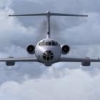
(russian for "excellent"!)
By the way, at #3 the site of first Moscowian airport is visible: Khodynka field behind the tailfin of the plane, the oval construction site with v-shaped buildings. In #15 it can be seen even better, the nose of the plane points towards it exactly.
At #10, do I spot some stock buildings standing amidst the scenery?
Harald Geyer Gründer der Messerschmitt Freunde Dresden v. V.

Phantom88 3,287
Amazing Detail :smile:
100% 75% 50% d8a34be0e82d98b5a45ff4336cd0dddc
tamsini 278

CRAZY BEAUTIFUL STUFF!
Mario Di Lauro
A320FAN 370
Very nice shots! Slava Rossii!
Otlichno! (russian for "excellent"!) By the way, at #3 the site of first Moscowian airport is visible: Khodynka field behind the tailfin of the plane, the oval construction site with v-shaped buildings. In #15 it can be seen even better, the nose of the plane points towards it exactly. At #10, do I spot some stock buildings standing amidst the scenery?
Thanks very much....yes i see FSX buildings in the scenery...the SDK will remove them!....Red Square has people taking pictures and buildings rendered in detail!
I can't believe it HLJ even has Russian scenery?
Appreciate the comment....the scenery is nicely done!
Many thanks...the detail is a suprise!
Big thank you!
Thank you very much!
Novation 534

Great combination of custom scenery.
Nice shots.
bernd1151 5,857
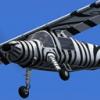
This must have been a ton of work. I wonder how many people are going to buy it, also their Warsaw scenery. I wish them the best of luck with these kinds of endeavour
Any attempt to stretch fuel is guaranteed to increase headwinds
My specs: AMD Radeon RX6700XT, AMD Ryzen 9 5900X, 32GB RAM, 34" monitor, screen resolution: 2560x1080
Thanks very much for commenting!
Nice shots. nebojsa
Many thanks for commenting!
Appreciate the comment....making scenery is not profitable it's a labor of love and nationalistic pride!
Create an account or sign in to comment
You need to be a member in order to leave a comment
Create an account
Sign up for a new account in our community. It's easy!
Already have an account? Sign in here.

Tom Allensworth, Founder of AVSIM Online

- Existing user? Sign In
- AVSIM Front Page
- AVSIM Library
- Latest Library Additions
- Subscribe to Library List
Rules & Policies
- AVSIM Screen Shot Rules
- Signature Rules
- Terms of Use
- AVSIM's Policy on Copyrights
AVSIM History
- The Janitor - An Interview with Tom Allensworth
- Interview with Joshua Howard Re MS FLIGHT - March 2012
- Interview with LMOC Re P3D - September 2012
- The AVSIM Hack - First Published in May, 2009
- The AVSIM Hack - The Full Story - Published April 2013
- Create New...

IMAGES
VIDEO
COMMENTS
Erik Lerouge is the architect behind fast cruising catamarans such as the O-Yachts Class 4, the Lady Hawke 33, the Freydis 430, the Barramundi 470 and the Brazapi 51. ... If you spot a catamaran with a fast, sleek design and a curved cross-beam, the chances are that it is a Lerouge cat. Examples of Erik Lerouge Catamarans. ... First Vaan Yacht ...
YACHT DESIGNER Since 1976, Erik LEROUGE, IFAN naval architect, has designed over 300 different sailing yachts built all over the world. ... Erik LEROUGE has an impressive technical background and his design concepts has been validated by tank testing. ... Some other victories of Erik LEROUGE's sailing designs 1986, 1994 and 1995 Multitonic ...
Join us on this walkthrough of Erik Lerouge designed Brazapi 51. https://www.sailtahiti.com/en/portfolio-items/lerouge-brazapi-51-2014/ A performance cruisi...
For the same cost of materials, I would prefer to design a simpler but longer hull with simple flare, such as on my PULSAR 31. In normal sub-gale conditions, the knuckle also adds to the dryness of the boat. Comparing boats by their length has always been the big drama of yacht design. This is done for harbour fees, custom, racing rules or ...
ERIK LEROUGE YACHT DESIGNS La Touche 85240 FOUSSAIS-PAYRE, FRANCE Tel: +33 (0)2 51 51 46 45 Email: [email protected]. Suggest Improvements Source: sailboatdata.com / CC BY. Advertisement. 2 Sailboats designed by Erik Lerouge. Sailboat. Manta 40.
Manta 40 is a 39′ 7″ / 12.1 m catamaran sailboat designed by Erik Lerouge and built by Endeavour Catamaran Corp. and Endeavour Yacht Corp. starting in 1994. ... The lower a boat's ratio is, the less power it takes to drive the boat to its nominal hull speed or beyond. ... Based on an earlier design (FREYDIS) by Erik LeRouge. Extended ...
Summary. The O-Yachts Class 4 is a 45 foot catamaran designed for safety at speed by one of the legends of multihull design: Erik Lerouge, and built under the direction of Dan Levy: a fanatic on the details. With her semi-carbon construction as standard, this is a well organised, strong and rigid catamaran that gives you plenty of bang for your ...
Electric Yacht. Boating Closeout Non-BR. Pelagic Autopilots. top 1 ads row1. top 2 ads row2. top 3 ads row2. Erik Lerouge . erik.lerouge.pagesperso-orange.fr. ERIK LEROUGE YACHT DESIGNS La Touche 85240 FOUSSAIS-PAYRE, FRANCE Tel: +33 (0)2 51 51 46 45 Email: [email protected]. Sailboats Designed By Erik Lerouge.
nautical designer who designed sailboats ... read more on Sailing The Web, the ultimate sailboat database
Sailing the fast Catamaran Wild One - Barramundi 470 - Design Erik Lerouge - Built 2011
Cénou is a Freydis 46 designed by Erik Lerouge. It offers a blend of comfort and performance. Able to sail at or better than wind speed in lighter winds, Cénou is easily driven and will average 8 to 10 knots all day in heavier air, rewarding those who like to sail without leaving behind comfort. Because the boat is so responsive to sail trim ...
Erik Lerouge is one of the most prolific multihull architects and we owe many high-performance boats to him. In 1985, he designed the Azuli, a simple and (very) fast cruising boat. Vik 113 is the worthy successor of this emblematic boat. Available for home-build, the catamaran generates a feeling of minimalism and the conviction that pleasure ...
Our Boat Review Video. Finance your Libertist 853 - Folding Version. Available in issue # 192. Boat Test price $5.00Inc. tax. Purchase. Erik Lerouge is well known for his highly seaworthy, performance multihulls - undeniable qualities that the architect defends thanks to an uncompromising vision. The Libertist 853, for example, was launched in ...
Erik Lerouge, water and wind architect. An experienced sailor who often participates in regatta races, a devoted sailing fan with vast expertise, and impressive experience in yacht design. No matter whether he sails downwind or upwind, his designs always go against the current. They are characterized by an innovative approach towards applied ...
We are building new tri - Libertist 850 - Erik Lerouge bigger P26. Feel free to comment. ... Boat Design Net. Home Boat Design Forums > Design > Multihulls > New 850 tri by Erik Lerouge. Discussion in 'Multihulls' started by Libertist, May 26, 2017. Joined: May 2017 Posts: 15 Likes: 7, Points: 3 Location: Poland Libertist Junior Member.
Erik Lerouge - You will get all the details of the designer Erik Lerouge over this page, and you can also checkout boats of this designer as well. Search Search. HOME; SAILBOATS; EXPLORE; BUILDERS; DESIGNERS; TOPICS. ... Boat Name Year Action Action; MANTA 40: 1994: Open Boat Details:
Location: Cruising in the SUN! Now hauled out in Malta for the winter. Boat: 37' Oldenziel cat. Posts: 461. Re: Lerouge design cats. I have not sailed the OP's Lerouge size cats yet but have chartered a 11.6m Lerouge designed Azuli. The best I can decribe her is a "real sailor's cat". I also test-sailed a 33' Rackham, again a perfect "sailor's ...
Lagoon have released the first images of their new model, the Lagoon 43. New for 2024, the Lagoon 43 pulls in design elements of the 55, 51 and 60 into a new forty-three footer sailing catamaran. Read our Lagoon 43 Review for more details on this sailing catamaran. More details: on " Club Lagoon ". She'll be shown at the Cannes Yachting ...
Published on August 25, 2016. Share. Earlier this year the development of a new Street Design Standard for Moscow was completed under a large-scale urban renovation program entitled My Street, and ...
The exhibition's curator Jean-Louis Cohen explains that Le Corbusier saw Moscow as "somewhere he could experiment.". Indeed, when the architect was commissioned to construct the famous ...
Facts. 164 000 m² total area. 246 m tower height. 55 aboveground floors. 60 000 m² cold-formed glazing area. 1 floor in 6 days the speed of erection of the building frame. 1 350 underground parking capacity. 90° angle of reflection on the façade. 156° turn the building by around its axis.
Drzewiecki Design Moscow City X Drzewiecki Design Sheremetyevo X M Design Domodedovo Airport Thanks for viewing!